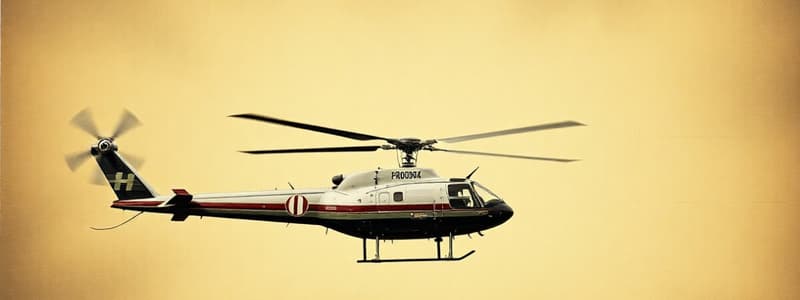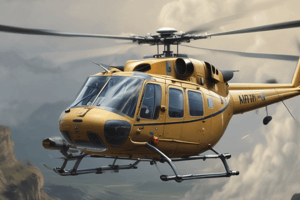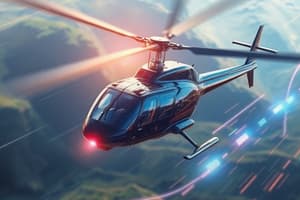Podcast
Questions and Answers
During normal helicopter operation, what is the direction of airflow through the main rotor?
During normal helicopter operation, what is the direction of airflow through the main rotor?
- Variable, depending on airspeed
- Horizontal, parallel to the rotor plane
- Upward, assisting lift production
- Downward, caused by rotor thrust (correct)
What occurs to the airflow direction through the rotor system when a helicopter engine fails and autorotation begins?
What occurs to the airflow direction through the rotor system when a helicopter engine fails and autorotation begins?
- It remains downward, but at a reduced rate.
- It ceases entirely due to lack of engine power.
- It becomes turbulent and unpredictable.
- It reverses and flows upwards through the rotor. (correct)
Why is maintaining main rotor RPM (Nr) critical during autorotation?
Why is maintaining main rotor RPM (Nr) critical during autorotation?
- To avoid overspeeding or decaying of the rotor, both leading to loss of control. (correct)
- To prevent the engine from restarting unexpectedly.
- To ensure the tail rotor remains effective for directional control.
- To keep the hydraulic systems pressurized.
What is the likely outcome if the main rotor RPM (Nr) decreases too much during autorotation?
What is the likely outcome if the main rotor RPM (Nr) decreases too much during autorotation?
Why is forward speed or sufficient altitude crucial for a successful autorotation?
Why is forward speed or sufficient altitude crucial for a successful autorotation?
What defines the 'dead man's curve' in helicopter operations?
What defines the 'dead man's curve' in helicopter operations?
In a real autorotation, what is the first action a pilot should perform?
In a real autorotation, what is the first action a pilot should perform?
In what direction should the pilot turn the aircraft during autorotation and why?
In what direction should the pilot turn the aircraft during autorotation and why?
What is the recommended forward speed for a helicopter during autorotation?
What is the recommended forward speed for a helicopter during autorotation?
During descent in autorotation, should the pilot actively monitor the main rotor RPM (Nr)?
During descent in autorotation, should the pilot actively monitor the main rotor RPM (Nr)?
What maintenance action ensures the autorotational RPM is within the proper range?
What maintenance action ensures the autorotational RPM is within the proper range?
How should the blade pitch be adjusted if the autorotation speed is too high?
How should the blade pitch be adjusted if the autorotation speed is too high?
What parameters are recorded at the beginning of a descent to check main rotor autorotational RPM?
What parameters are recorded at the beginning of a descent to check main rotor autorotational RPM?
According to the provided text, which of the following two factors affect how fast the blades will spin during autorotation?
According to the provided text, which of the following two factors affect how fast the blades will spin during autorotation?
What adjustments should be made if after plotting density altitude and gross weight there is a determination that rotor RPM is too low?
What adjustments should be made if after plotting density altitude and gross weight there is a determination that rotor RPM is too low?
Flashcards
Autorotation
Autorotation
The process of producing lift with rotor blades freely rotating from a flow of air up through the rotor system.
Autorotation Airflow
Autorotation Airflow
Occurs when the engine is no longer producing power, causing airflow to reverse and come from below the rotor.
Nr (Main Rotor RPM)
Nr (Main Rotor RPM)
The main rotor RPM during autorotation that must be maintained within a safe level to prevent overspeed or decay.
Dead-man's curve
Dead-man's curve
Signup and view all the flashcards
Pilot Actions for Autorotation
Pilot Actions for Autorotation
Signup and view all the flashcards
Parameters to Record
Parameters to Record
Signup and view all the flashcards
Density altitude
Density altitude
Signup and view all the flashcards
Factors Affecting Blade Spin
Factors Affecting Blade Spin
Signup and view all the flashcards
Using Autorotation Chart
Using Autorotation Chart
Signup and view all the flashcards
Study Notes
- Autorotation is the process of producing lift with the rotor blades as they freely rotate from a flow of air up through the rotor system.
- The ability of a helicopter to autorotate is a feature that separates it from fixed-wing aircraft from a safety perspective.
- With an engine or power train failure, the rotor system disengages, leaving the rotor system to move freely in its original direction and produce lift, allowing the helicopter to glide.
- During normal operation, the flow of air going through the main rotor is downward.
- When the engine is no longer producing power, or is disengaged from the rotor, the flow of air transitions to upward.
- This upward flow of air through the rotor allows it to continue turning.
- During an autorotation, the main rotor RPM, known as Nr, must be maintained at a safe level.
- If Nr increases too much, the main rotor will overspeed, potentially causing structural damage; pulling a very slight collective can slow the rotor by increasing drag.
- Insufficient Nr can cause the helicopter to descend rapidly due to a lack of stored energy in the blades needed to slow the descent rate.
- A helicopter needs to be sufficiently high or moving forward with enough speed to execute a successful autorotation.
- If the engine fails when the helicopter is too low or moving too slowly, a crash is inevitable.
- Flight operations in a zone of unsafe altitude and airspeed combinations is known as the dead-man's curve.
- Autorotation is an emergency procedure for the pilot.
- In a real autorotation event, the pilot should:
- Reduce collective to low pitch
- Turn the aircraft into the wind
- Establish a forward speed of 60 mph
- Find a suitable landing spot
- The pilot does not need to monitor the Nr during descent.
- Maintenance is responsible for ensuring the autorotational RPM is within a satisfactory range.
- Adjustments are made during the rigging of the Collective Controls, with a focus on ensuring the correct lowest pitch angle.
- To correct autorotation speed:
- Increase the blade pitch if the speed is too high
- Decrease the blade pitch if speed is too low
- Checking the main rotor involves going flying with the pilot when the throttle is idled to enter an autorotation.
- During the descent record:
- Altimeter reading (pressure altitude)
- OAT reading (temperature of the air at that altitude)
- Nr tachometer reading (main rotor autorotational rpm)
- The speed of the rotor blades is affected by:
- Gross weight; (a heavier aircraft results in faster blade spin)
- Air density (the denser the air the slower the blades will spin)
- The density of the air is the "density altitude."
- Density altitude is found combining the "pressure altitude" with the "oat" reading
- Charts for calculating density altitude and acceptable autorotational rpm values are available.
- To use the Autorotation Chart:
- Plot Density Altitude from infomation
- Using Gross Weight identify which row is applicable
- Select appropriate column based on the the density altitude
- Compare Autorotation to ensure correct rigging
- Adjust main rotor head pitch links to increase or decrease as needed
- Blades need more drag and more drag need the pitch angle to increase.
Studying That Suits You
Use AI to generate personalized quizzes and flashcards to suit your learning preferences.




